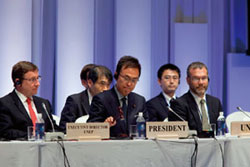Feature
Report on the Conference of Plenipotentiaries for the
"Minamata Convention on Mercury"
The Conference of Plenipotentiaries for the Minamata Convention on Mercury was held from October 9th to 11th in Kumamoto and Minamata, Japan. More than 1,000 participants, including more than 60 Heads of State and Ministers, participated in the Conference. During the conference, which was chaired by Mr. Ishihara, Minister of the Environment of Japan, the Minamata Convention on Mercury was unanimously adopted and signed by as many as 92 representatives including Japan.
1. The Conference of Plenipotentiaries on the "Minamata Convention on Mercury"

The adoption of the Convention
The "Minamata Convention on Mercury" stipulates comprehensive regulations through the whole life cycle of mercury, including production, use, emissions, and disposal, aiming at reducing the risk of mercury on human health and the environment.
In January 2013, the draft text of the convention was agreed after five times of inter-governmental negotiations since 2010. From October 9th to 11th, the Diplomatic Conference was held for adopting and signing the Convention in Kumamoto and Minamata (Preparatory Meeting was also held on October 7th and 8th).
More than 1,000 delegations from 139 countries, international organizations, and NGOs participated in the Conference.
2. Adoption and signing of the Convention
The Ceremonial Opening was held in Minamata on October 9th. Prime Minister Abe delivered his message, in which he called for the eradication of mercury damage and announced the support of $2 billion in total over the next three years for environmental pollution control measures in developing countries. Mr. Ishihara, Minister of the Environment of Japan, also expressed his initiative, which includes the support of developing countries for the early entry into force of the Convention, as well as delivery of information on the environmental restoration and mercury technique in Minamata to the world. Prior to the Ceremonial Opening, participants from the world joined a floral tribute at the Cenotaph for Minamata Disease Victims, and tree-planting ceremony. They also visited Minamata Disease related museums to learn the history of Minamata.
On October 10th and 11th, the Diplomatic Conference was held in Kumamoto. First, the final protocol of the Diplomatic Conference and the Minamata Convention on Mercury were adopted by consensus, followed by a signing ceremony. 92 countries in total, including Japan, signed the Convention until October 11th. Then, the statements by the representatives were delivered; the importance of the Convention and congratulations on the adoption of the Convention; the need for early entry into force; and appreciation for the unforgettable warm hospitality ("Omotenashi") of the local community were referred to.
3. Evaluation and future response to the Convention
The fact that ministers of more than 60 countries attended the conference and 92 countries signed the Convention shows the strong will of the international community for mercury regulation. Japan has been negotiating with a strong determination based on the lessons learned from Minamata Disease. Similar environmental pollution and health damage should not be repeated again. Hosting the Conference and signing the Convention showed our strong commitment towards strengthening measures against mercury to the international community.
Japan will proceed to set up national legislation required for the ratification of the Convention and to extend assistance to developing countries.
MORE Information
MOYAI Initiative (tentative translation) -- MOYAI from Japan to the World --
Supporting developing countries' efforts
| Financial support | Technological support | |
|
|

Corporation for a early entry into force of the convention

Transmission and communication from Minamata
| Technology development and transfer | Global model for environmental revitalization | |
|
|
*1 the National Institute for Minamata Disease
*2 "Moyai" refers to the "Moyai-Net", which is used to tie ships together, and also the "Moyai" collaboration practice at farming communities.
"Moyai-naoshi" represents the initiative to face the issue of Minamata Disease and collaborate through dialogs to regenerate the community.

Delivery information on preventing pollution and environmental revitalization of Minamata to the world

Realization of a global "Moyai-naoshi"
(integration of the environment and economy)


